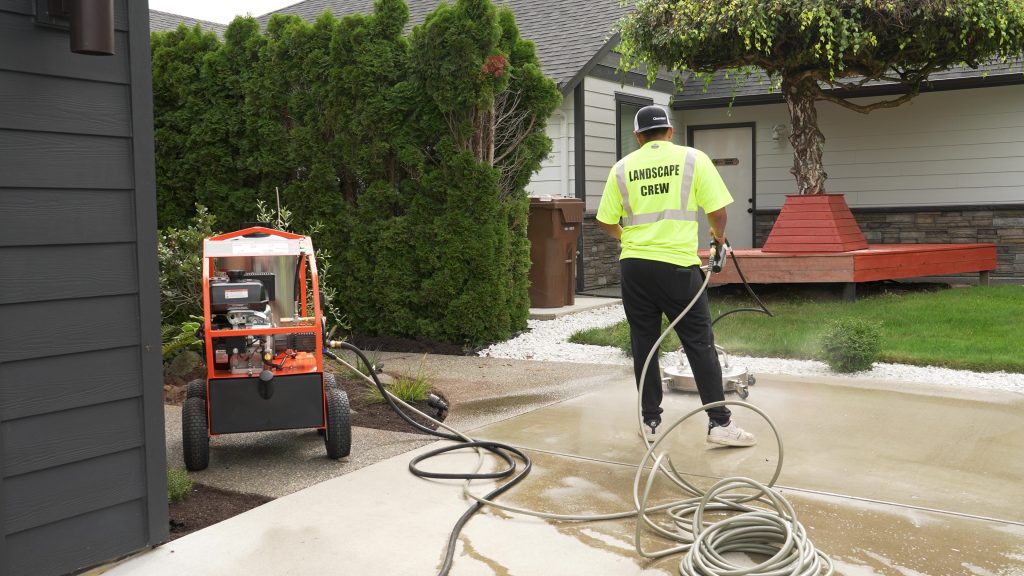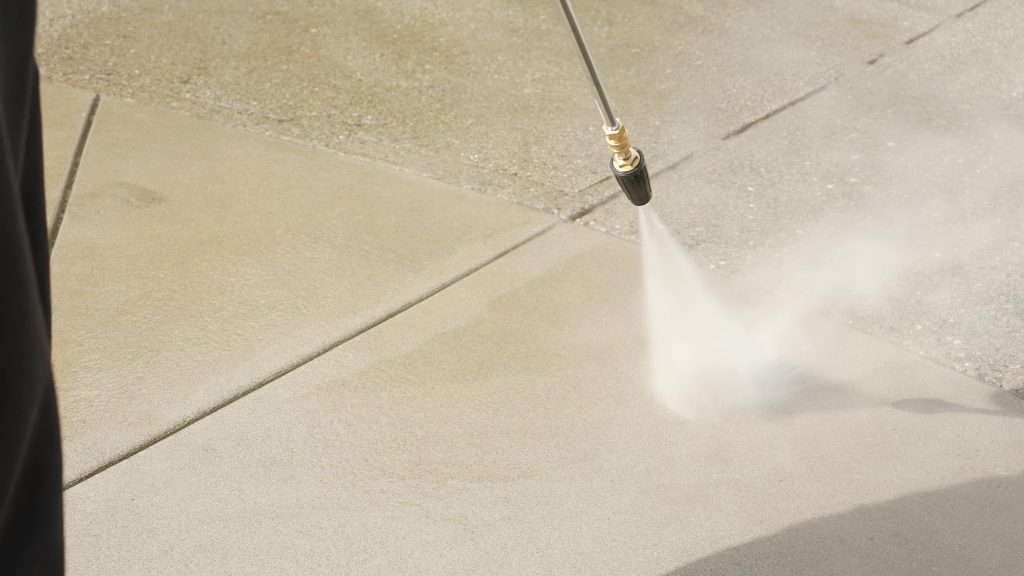Keep Your Building Looking Its Best Without Risking Damage
Maintaining the appearance and integrity of your building’s exterior isn’t just about making a good impression. It’s about protecting your investment. Not every surface should be cleaned the same way, and using the wrong method can do more harm than good. At Cleanstart, we help clients choose the right approach, power washing vs. soft washing, based on their property’s unique needs. If you’re dealing with heavy grime or organic growth, here’s what you need to know.
Keeping the outside of your building clean isn’t just about looking good; it’s about preventing wear and damage that can cost you later. Whether you manage an office park, retail center, apartment complex, or industrial facility, people notice the exterior first. But here’s the thing: not all exterior cleaning is the same, and choosing the wrong method can do more harm than good.
Power washing vs. soft washing all depends on what you’re cleaning and what you’re trying to accomplish. Are you dealing with years of grime on concrete? Or is mold and algae creeping along your stucco walls? Different issues call for different methods. The wrong choice could leave you with peeling paint, water damage, or even structural issues if not done correctly.
Choosing the Right Method for Your Building: Trust in Our Expertise
What Is Power Washing?
Think of power washing like a high-pressure shower for your toughest surfaces. It’s water under serious force, sometimes heated, to knock loose everything from dried gum to oil stains to thick grime that’s been sitting there for years.
It’s kind of like the difference between wiping your shoes on a doormat versus blasting them clean with a hose. When you’ve got concrete walkways that have turned black from foot traffic, or a warehouse dock coated in years of grease and dust, power washing is the go-to.
Here’s where power washing shines:
- Concrete sidewalks and driveways – You know those walkways where gum, coffee spills, and dirt have fused with the concrete? This is how you bring them back to life.
- Brick walls – especially on older commercial buildings, where mildew or city grime has built up.
- Parking lots – Between oil leaks, tire marks, and spills, these take a beating.
- Loading docks – High traffic, high mess. Power washing can help keep things safe and presentable.
- Industrial equipment zones – This is where power meets practicality. You need something aggressive enough to clean without shutting down operations for a week.
- Power washing isn’t right for everything. Use that much force on painted wood, aging stucco, or roof shingles, and you’re asking for trouble. It can strip paint, crack siding, blow water into vulnerable areas, and even ruin seals around windows and doors. While power washing is an excellent option in the right scenario, it has to be used carefully and strategically.
That’s why, when we do a job, we don’t just show up with a pressure wand and go to town. We take the time to evaluate the materials, the type of buildup, and the condition of the surface before recommending the method.
What is Soft Washing?
So let’s say you’ve got the opposite problem. You’re not dealing with grease stains or ground-in dirt on concrete, but instead you’ve got black streaks running down your siding, or patches of green moss creeping across the roof. That’s when soft washing becomes the smarter, safer option.
Soft washing is the gentle-but-smart alternative to power washing. It still uses water, but at a much lower pressure. The real power comes from the specially formulated cleaning solutions that do the heavy lifting. These solutions break down things like mold, mildew, algae, and bacteria right at the root, without damaging the surface underneath.
It’s the method we use when we want to treat the problem, not just blast away the symptom. And the bonus? It’s incredibly effective without the risk of stripping paint, cracking stucco, or forcing water into places it shouldn’t go.
Here’s where soft washing shines:
- Stucco and painted siding – These surfaces can crack or peel under high pressure, but soft washing keeps the finish intact while removing algae and grime.
- Vinyl siding – Pressure washing can dent or loosen vinyl panels. Soft washing gets it clean without causing wear and tear.
- Roofs (mainly shingle and tile) – High pressure on a roof can dislodge shingles or send water up under them. Soft washing is the recommended method by most roofing manufacturers to kill moss, algae, and those black streaks.
- Wood decks and trim – Wood is porous and can splinter or soak up water when hit with high pressure. Soft washing keeps it safe while lifting stains and mildew.
Delicate signage or exterior trim – Anything with decorative details, seals, or coatings benefits from this approach.
One of the things we love about soft washing is that it’s not just surface-level cleaning. Because the solution is designed to kill and remove organic growth, the clean lasts longer. You’re not just making it look good, you’re keeping mold and mildew from coming back so quickly.
Plus, from an environmental perspective, soft washing uses less water, and the solutions we use at Cleanstart are biodegradable and eco-conscious. Not only is it safer for your building, it’s also better for the surrounding landscaping, stormwater systems, and anyone walking nearby.
Key Differences at a Glance
So now that we’ve walked through what power washing and soft washing are, let’s take a step back and look at how they differ side by side. Think of it this way:
- Power washing is all about force. It’s your go-to when you’re dealing with tough, caked-on grime that won’t budge, like grease stains, mud, or years of grit on concrete. It relies on high pressure (and sometimes hot water) to knock that stuff loose. But it’s not a precision tool. You wouldn’t use a hammer to fix a watch. Same idea here; it’s powerful, but you need to know when to use it.
- Soft washing is about strategy. Instead of pressure, it uses specially formulated solutions to break down and lift away organic growth like algae, moss, and mildew. And because it’s low pressure, it’s safe for delicate materials that can’t take a beating, such as painted trim, shingles, stucco, wood, or vinyl siding.
Here’s how it breaks down:
| Power Washing | Soft Washing | |
| Pressure Level | High pressure can be intense | Low pressure—gentle on surfaces |
| Cleaning Method | Physical force to blast dirt off | Chemical solution to break down the growth |
| Best For | Concrete, brick, and industrial surfaces | Siding, roofs, stucco, painted trim |
| Main Targets | Grime, grease, oil, heavy buildup | Algae, mildew, mold, pollen, and organic stains |
| Water Usage | Typically uses more water | Uses less water with biodegradable solutions |
| Surface Risk | Can damage fragile or painted materials | Safe for most building exteriors |
Many people assume power washing is the default. However, soft washing is often the better, more sustainable option, especially for the kinds of buildings we see every day: mixed materials, aging finishes, roofs that aren’t designed to take heavy pressure. We look at your building’s surfaces, your goals, the type of staining or buildup, and then choose the correct method to get the best results without causing unnecessary wear.
The Cleanstart Difference
We take the time to evaluate your building, your materials, your pain points, and your goals. Is your roof growing algae? Is your concrete stained from vehicle traffic? What sets us apart is our commitment to using the proper method for the right surface every time. We don’t power wash delicate materials to get it done faster, and we don’t soft wash concrete when we know it won’t be enough. Our exterior property cleaning crews are trained to see the difference and bring both the tools and the expertise to back it up.
And because we care about what we leave behind, we use environmentally responsible cleaning solutions that are biodegradable, effective, and safe for your building, landscaping, and surrounding areas. That means we’re not just protecting your property. We’re also protecting the people who live, work, or visit there.
Whether we’re restoring a storefront façade, refreshing a multi-tenant building, or maintaining a large commercial property, our goal is always the same: to deliver results that look great, last longer, and never cause harm. That’s the Cleanstart difference and why so many clients trust us to maintain their exteriors year after year.
Let Us Handle The Details So You Don’t Have To
At Cleanstart, we don’t guess. We evaluate your property, consider the materials, the buildup, and your long-term goals before deciding on a cleaning method. Sometimes you need strength, sometimes finesse—and we bring the right mix of both. Whether it’s heavy grime or organic growth, we’ve got your exterior covered.
Contact us today to schedule a professional assessment and let us recommend the safest, most effective method for your building. With Cleanstart, you get expert results, long-lasting protection, and service you can count on.









